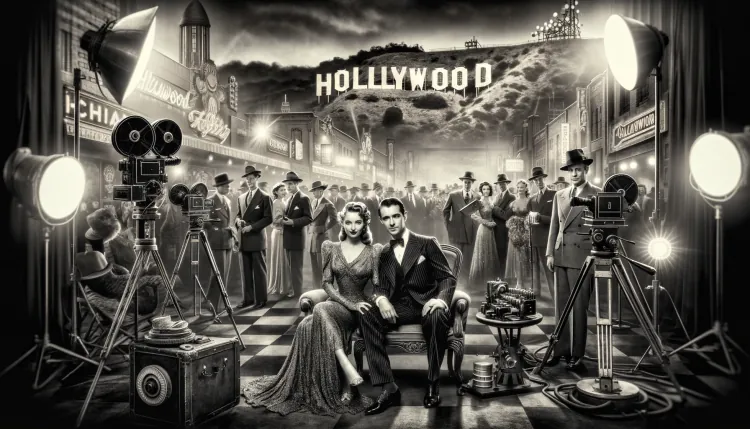Hollywood's Golden Era: The Rise of the Studio and Star Systems
The origins and impact of Hollywood's studio and star systems, shaping cinema and global culture throughout the 20th century

-
Introduction
- Overview of Hollywood’s impact on global cinema and culture.
-
Origins of Hollywood
- Geographic, economic, and legal factors behind Hollywood’s establishment.
- Migration from New York and New Jersey to avoid Edison's patents.
-
Development of the Studio System
- Formation and dominance of major studios (Paramount, Warner Bros., MGM, Universal).
- Vertical integration: control over production, distribution, and exhibition.
-
Birth of the Star System
- Concept and implementation of the star system by Hollywood studios.
- Role of stars in attracting audiences and increasing film profitability.
-
Creating Stars
- Studio strategies in managing and promoting stars.
- Public persona management and the impact on stars’ personal lives.
-
The Impact of the Star System
- Marketing benefits and audience loyalty driven by stars.
- The pressure and constraints placed on stars by the system.
-
Transition and Decline
- Challenges to the studio and star systems in the 1950s.
- Legal and cultural shifts, including the impact of the Paramount Decree.
-
Legacy
- Enduring influences of the studio and star systems on modern cinema and celebrity culture.
-
Conclusion
- Recap of Hollywood's role in shaping film and global cultural perceptions.
-
FAQs
- What led to the rise of Hollywood as the film capital?
- How did the star system change the film industry?
- What was the Paramount Decree, and why was it significant?
Introduction Hollywood's ascension to the epicenter of the global film industry is a tale of ambition, innovation, and the creation of American cultural icons. The early 20th-century development of both the studio system and the star system not only shaped American cinema but also defined how films influenced and reflected societies worldwide.
Origins of Hollywood The birth of Hollywood as the world’s film capital was driven by a combination of geographical, economic, and legal factors. Filmmakers moved to Southern California to escape the stringent enforcement of Thomas Edison's motion picture patents, prevalent in the northeastern U.S. The region’s ideal climate and diverse scenery provided perfect backdrops for various film genres, facilitating year-round production.
Development of the Studio System During the 1910s and 1920s, giants like Paramount, Warner Bros., MGM, and Universal established themselves, creating an infrastructure that controlled the entire filmmaking process. This vertical integration allowed these studios to dominate the industry, from the scripts that were produced to the theaters that showed the final films.
Birth of the Star System Simultaneously, Hollywood developed the star system, which became a strategic tool to attract audiences through charismatic figures such as Charlie Chaplin and Mary Pickford. These stars became central to studio marketing strategies, turning films into must-see events based on the actors' allure alone.
Creating Stars Studios meticulously crafted and controlled their stars' public images to maximize their appeal and marketability. The personal lives, public appearances, and even scandals were often orchestrated or mitigated to maintain the stars’ desirable personas.
The Impact of the Star System This system profoundly influenced the industry by enhancing film marketability and building strong audience connections to stars, which in turn bolstered box office sales. However, it also placed stars under intense pressure, often treating them as commodities rather than artists.
Transition and Decline By the mid-20th century, the landscape began to change due to legal challenges and the rise of television. The 1948 Paramount Decree, for instance, dismantled much of the vertical integration that had allowed studios to control the film market, signaling the beginning of the end for the traditional studio and star systems.
Legacy Despite these systems' decline, their legacies persist in the continued influence of star power in modern celebrity culture and the enduring role of studios in shaping film production and distribution.
Conclusion The rise of Hollywood fundamentally transformed the film industry, influencing global cultural landscapes and establishing enduring standards for celebrity and entertainment. Its story remains a pivotal chapter in the history of cinema.
FAQs
- What led to the rise of Hollywood as the film capital?
- Hollywood rose to prominence due to advantageous geographical conditions, legal maneuvering around patent restrictions, and strategic innovations in film production and marketing.
- How did the star system change the film industry?
- The star system shifted focus towards building movies around particular actors, significantly influencing marketing strategies and audience engagement.
- What was the Paramount Decree, and why was it significant?
- The Paramount Decree was a landmark antitrust ruling that forced major studios to divest their theater chains and end certain monopolistic practices, reshaping the film industry.
Explore more about the captivating history of Hollywood and its lasting impact on cinema at Kiksee Magazine.
What's Your Reaction?






















